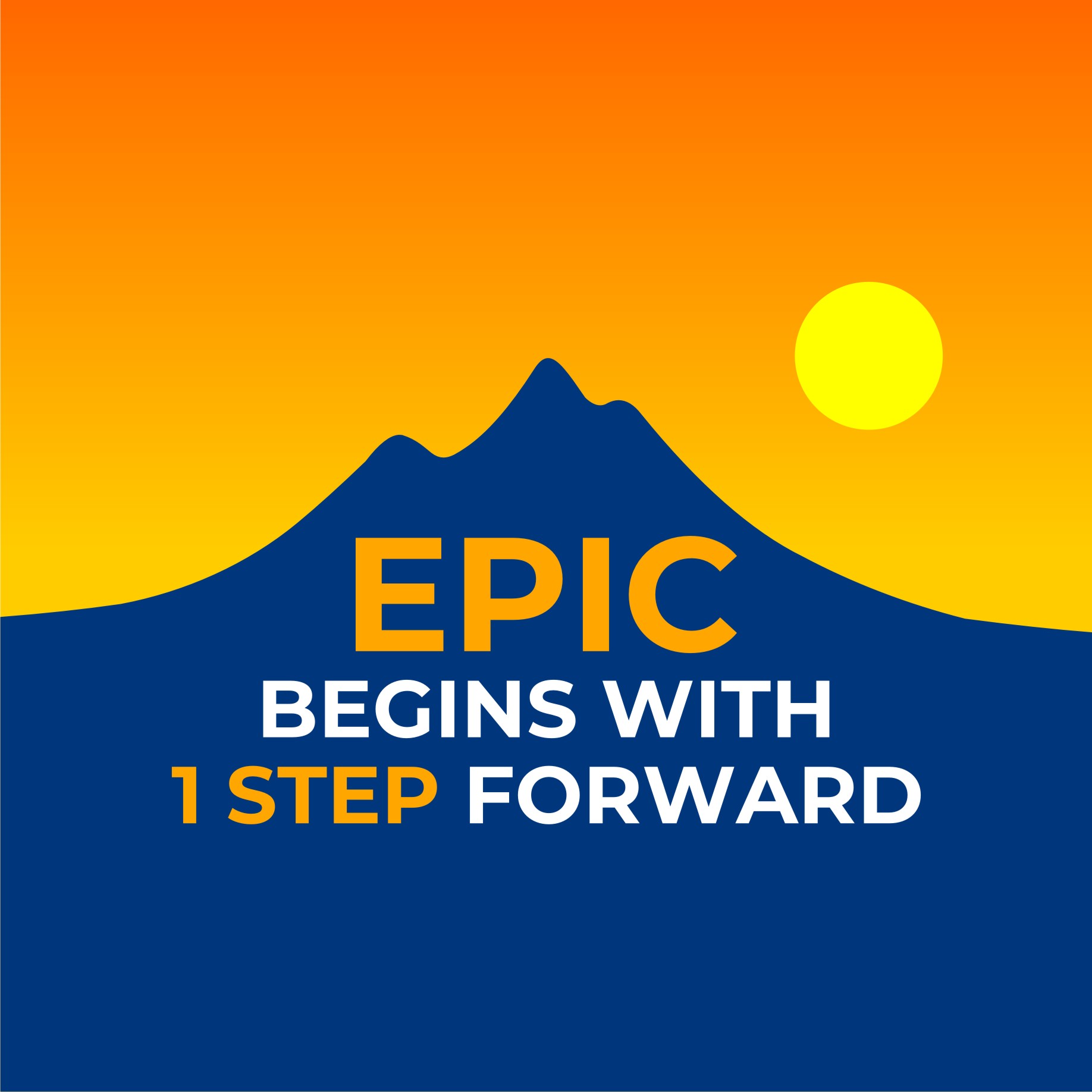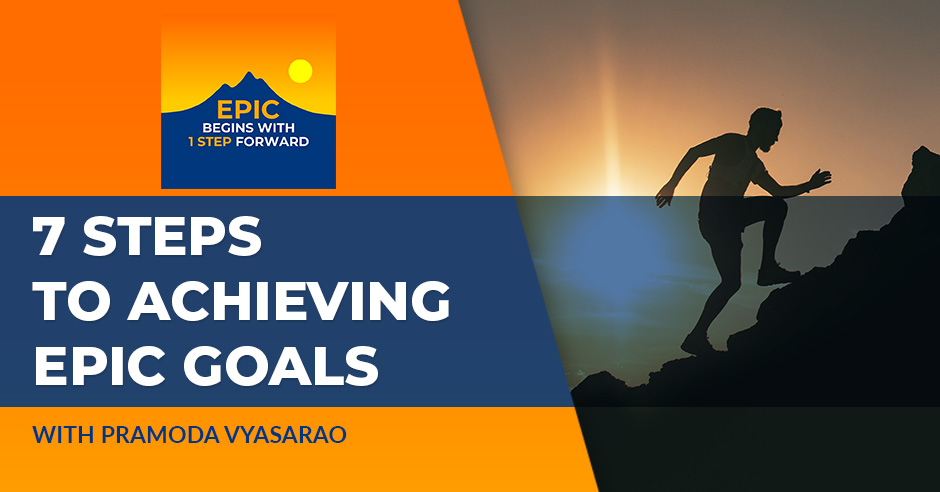Have you ever wondered if there’s a foolproof method to achieve your goals? In this episode, Pramoda Vyasarao, an experienced coach and author, reveals his powerful 7-step framework for goal setting success. From setting clear objectives to overcoming obstacles, Pramoda shares invaluable insights gained from his personal journey and years of coaching tech professionals. Join us for a lively and inspiring conversation that will equip you with practical strategies to turn your aspirations into reality. Whether you’re looking to advance your career, start a business, or pursue personal growth, this episode is packed with actionable advice to help you unlock your full potential.
—
Listen to the podcast here
7 Steps To Achieving Epic Goals With Pramoda Vyasarao
Introducing Pramoda Vyasarao
Welcome back to another exciting episode of Epic Begins with One Step Forward. I’m your host, Zander Sprague. I am joined by Pramoda. Pramoda, please introduce yourself and tell us who you are and what you do.
I’m excited to be here on the show. My name is Pramoda Vyasarao. I grew up in India and I now live in California for the last ten years. I have an engineering background and a master’s degree in Computer Engineering. I lived in India until 2015. I worked in the technology industry for a long time, including companies like Oracle and Facebook, which is now called Meta. In the last eighteen months, I have been on my own.
I run a coaching company called Changesmith Coaching, like blacksmith and goldsmith. A changesmith is a person who is skilled in consciously changing their thoughts and behaviors. I call them changesmiths. I have digital courses, live courses, and one-to-one coaching for the technology community. My audience is primarily from the engineering and technical fields.
I’m excited to find out more about that. One of the things that I do know and I’d love to start with is you’ve been on a bit of an epic journey. In 2023, you set out to accomplish just a little. Do you want to tell me what you set out to do and what you did achieve on this epic journey?
If you go back to my journey, in 2003, I knew that my personal development was leading me to help other people. I knew in my mind that one day, I would be a coach, author, and instructor, helping other people through my own transformation. I was waiting to turn 50 to do that. In 2023, as part of a massive layoff at Meta, my job was eliminated. I thought, “Should I wait to become 50 or start immediately?”
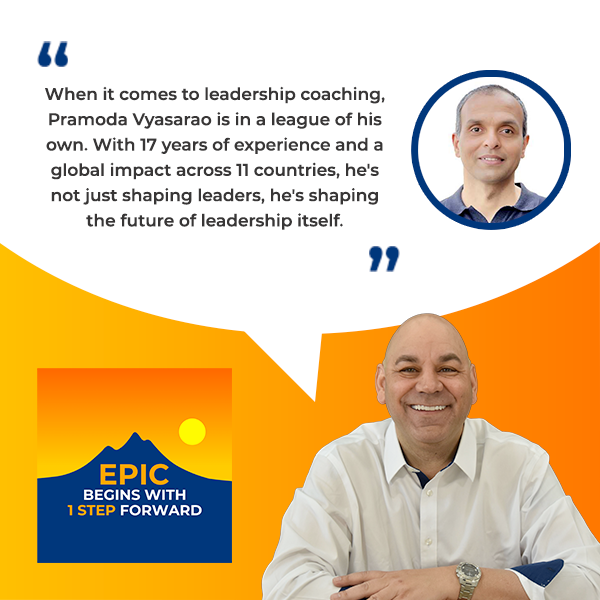
The answer was, “You’re 43 right now. Why don’t you take a two-year break and figure out if this is something you want to do and enjoy doing and monetize your experience from the last 21 years?” It felt like a big risk at the time, but I thought two years was not a big deal. I can take a break for two years and attempt this. I’ve been on this journey for eighteen months now. I made a lot of progress in the last eighteen months.
Don’t wait for the perfect moment to pursue your dreams. Start now and give yourself the time to figure it out. You might save years of your life and find unexpected joy in the journey.
What felt risky before is now enjoyable. I enjoy what I’m doing. I’m putting together a system and a funnel for my clients to work with me. The journey has been amazing. I can talk more about what I have done so far, but the journey has been amazing. It has been fulfilling. I can say this layoff saved seven years of my life.
The whole point of my book is we have epic things we want to do. Don’t wait. We all have stuff in our lives like, “Someday I’d like to do this. I’ll do this when I’m 50, tomorrow, next week, or whatever.” The fact of the matter is time goes by. Your life still goes on whether you participate today or not. I want to encourage people to see their epic even though they’re scared.
I get that because I also did the same thing. I worked in technology for 22 years, and I was also reduced in force, laid off, fired, transitioned, whatever term they want to use. I was out of a job and went and found other jobs. I had this moment like you did when I was doing technical instruction. I was teaching people how to use software. I have to say I was pretty good at it, but I knew in my heart that I had other stuff I was teaching on the side. I said, “Why am I teaching other people’s stuff when I know I want to teach my own stuff because I know it best?
I also went out there, and it is big and scary. It is good that you said, “I’ll give it two years. Let me see,” because now there’s a little urgency there. For you, what was one or two of those first steps that when you had been thinking about it before seemed perhaps impossible or not achievable, but when you did it, maybe you were like, “Okay.”
Writing A Book: From Impossible To Reality
I’ll give you one example. I had this goal of writing a book in 2005. I loved setting goals and achieving them every year. As I made good progress on my goals from 2003 to 2006, in three years, I thought I’d write a book about this to see how people can set goals and go beyond their limits. That book never came out from 2003 until 2021. After this layoff, I thought, “Why don’t I write a book? I have some time here.”
My passion is goal-setting, achievement, and personal transformation. “Why don’t I build my authority and credibility through a book?” Initially, it felt impossible. The book is in my hands now. I wrote the first page in October 2023. I took a timer and set it for 30 minutes. I started capturing what I would write in the book. It’s a very simple plot.
Instead of giving information to people, I don’t want to stand on a pedestal and say, “I have something to offer you. I am a PhD holder. I’ve done research on 1,000 people. Here is my information for you.” I didn’t want my book to be like that. My book needed to be a demonstration of my challenges, my personal goals, and whatever is meaningful to me.
Eighty percent of my book is a demonstration. It talks about all the goals I achieved in the last 21 years. I talk about 52 goals, including running a marathon in under four hours, donating blood 50 times, writing a nonfiction book, and starting my own coaching company. They’re all reasonable goals, but they are meaningful to me.
The book took a nice structure because all I wanted to communicate was my demonstration of goal achievement. I presented a seven-step framework for achieving any goal, be it personal or professional. In section three, I talk about the top three mistakes people make in goal setting. The book’s structure is very simple, easily readable, and digestible.
The Power Of Small Steps In Goal Achievement
I worked with a coach, Dr. Eric Maisel, who coached me in writing this book. He’s very popular in the creativity community. In four months, the manuscript was ready. In nine months, the book is out in all formats, eBook, audiobook, paperback, and hardcover. To go back, what felt impossible nine months ago is now a reality. One step at a time, I focused on putting one brick on the wall. In nine months, the wall was ready. I just put bricks on every day.
That’s exactly what I coach people about. I too have run marathons, not under four hours, but that’s good. A marathon is a long distance, I think you’ll agree. The way you do it is left, right, repeat. That’s what you have to do. You think about the big goal, but the fact of the matter is when you’re at mile 5, you have to deal with whatever is in front of you, be it a hill, the heat, a cramp, or whatever. People think about these big goals and it seems impossible like, “How will I ever do that?” I know I had always wanted to run a marathon, but I wasn’t a runner.
I got into running because I was working in the corporate world in high tech. As you know, high tech talks about work-life balance. However, you have to make it. They’re not going to help you. They’ll take 24 hours if you give them 24 hours. I found exercise hard. I found this funny dichotomy. I worked at Intel for five years, and they had a gym that I could use for free.
I wanted to workout to help reduce my stress level, but I was so stressed trying to get to the gym, get my workout, and be able to get back to my desk to make a meeting. I don’t think my stress level went down. It was a little higher each time I tried to go. I was like, “That’s not working for me.” I said, “I can run at 5:00 in the morning when I don’t have any meetings. I’ll go.”
When I started to do that, I said, “I’d like a goal.” I’ll go out and run 3 miles or whatever. When you’re trying to do more than 5, you have to have a reason to do it. It’s great that you love it, but didn’t you find that training when you knew you had a marathon that you needed to run? It helps justify, “I have to go out and run 12 miles.”
There are days. I remember some days I ran about 20 miles. Two or three weeks before the race, we usually run 18 to 25 miles to get ready and say, “Here’s my distance.” What I did was take my family’s help. I told my wife and son to come and meet me midway. When I was tired and not feeling energized to continue, they would come and remind me that I have a goal here and I am setting an example for others. They would give me refreshments, water, and some snacks. I use that as a trick to motivate myself to continue the other half. The first 90 minutes were easy on Sundays, but the difficult part was the next 90 minutes when you’re tired.
What marathon did you run?
I ran my first in San Diego. It was a full marathon. I did 4:04, four minutes beyond four hours. I wanted to achieve under four. The second one I ran was in Las Vegas. It was an evening race. My best time is 3:59, a full marathon at 3:59.
Good for you. I can’t say that my time is nearly that good, but it doesn’t matter. I completed them. I’m not running nearly as much now. Age is making it a little harder. I can still do it, but I’d rather ride my road bike.
Underestimating Long-Term Potential
One thing I’ve found over my years of experience in helping my clients is that we human beings underestimate what we can achieve in five years, and we overestimate what we can achieve in one year. I’ll give you a specific example. I ran my first 10K race when I lived in India in 2009. Maybe fifteen years ago, I ran my first 10K. It took me 75 minutes. In 2023 in San Jose, I ran a 10K. I finished in 43 minutes. I came first in my age category between 40 to 45. If you look at this, there has been a huge improvement over the last fifteen years. It’s a long time horizon. We underestimate what we can do over a long horizon.
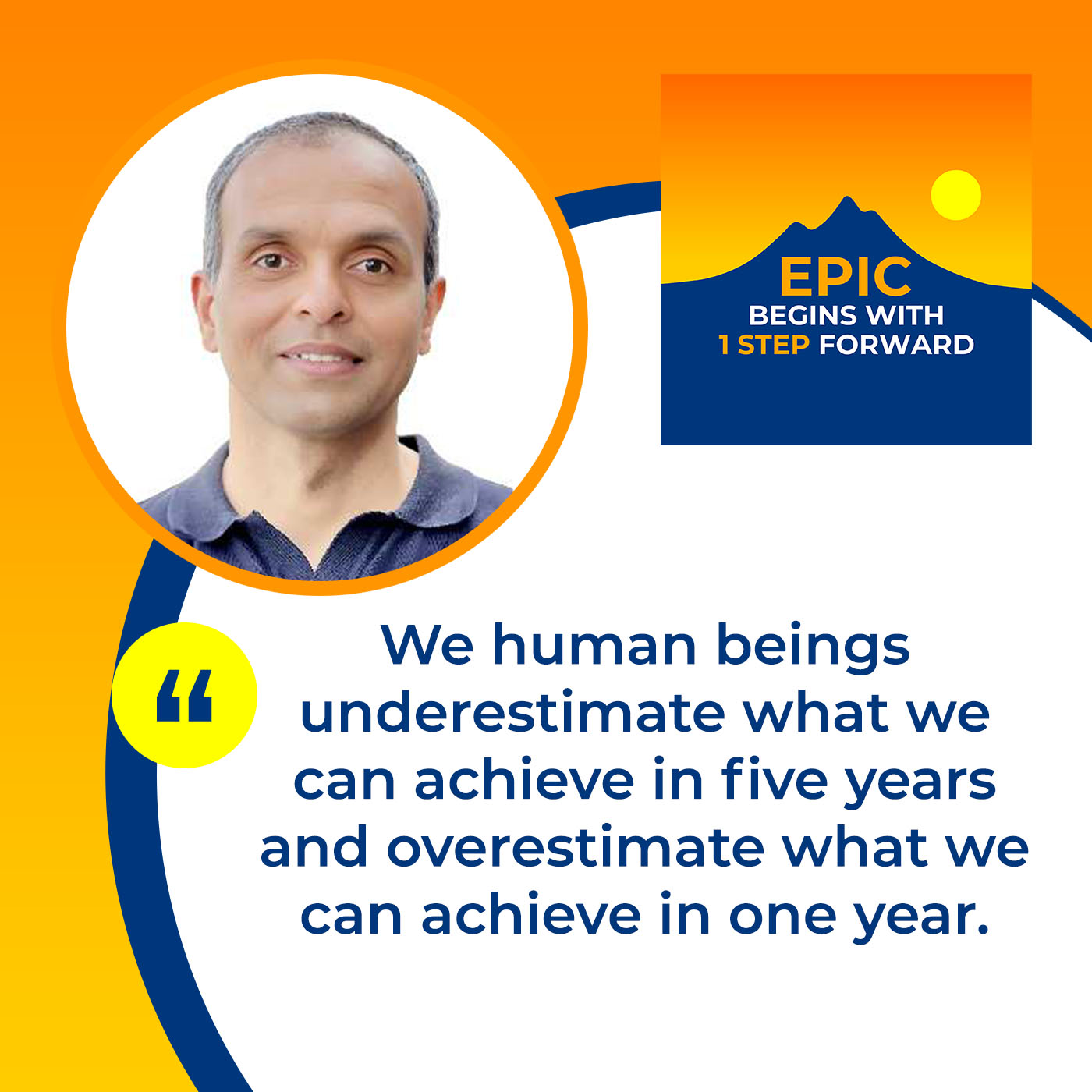
You’re a shining example of it, and you wrote about it in your book. It is that we all have done epic things and we’ll do epic things, but we’ve all achieved these epic things. Yet we somehow discount, downplay, or don’t give ourselves the credit for all these incredible things that we did. Less than 1% of the world’s population has completed a marathon. You and I have both done it. That’s pretty cool. More and more people are running marathons, and that’s awesome. It’s an incredible achievement even if you only do it only once. You get to say, “I’m a marathon finisher.” No one can take that away.
When I talk to people, they’re like, “I haven’t done anything epic,” and then I get curious and ask them about what they’ve done. In their work, they’ve done cool things. Maybe they did a job they never thought they would ever do. If you told them at twenty, “Here’s a job you’re going to do,” they’d be like, “What are you talking about? There’s no way I’m doing it.”
I wrote three books and I can tell you, I’m a talker, not a typer. It blows my mind that I’ve written three books because I don’t like writing. I figured out how to do it. I agree that telling your own story in a book is so much more helpful than standing up on the pedestal saying, “I am such an expert.” We’re experts in our own lives.
That is true. Personal examples are very inspiring because I can relate to them and say, “I know this person’s background. If he has done it or she has done it, I can do it too.” A personal connection comes through with that person’s examples and stories because they inspire other people.
We often underestimate what we can achieve in five years but overestimate what we can do in one. Set long-term goals and be patient with your progress. You might surprise yourself!
They do. Think about it. The Olympics just got back. I don’t know if you watched any of it. I watched some of it. I love some of the stories that come out of the Olympics. There’s one of them that I was like, “This is phenomenal.” I’m spacing on her name, but the woman who won the women’s road bike. She’s an American. No one had picked her. She was an alternate. The woman who qualified was also doing the triathlon and said, “I want to focus on the triathlon,” so she gave her spot. This woman, I’m not going to have her name, was a rower in college and didn’t pick up road bikes until seven years ago.
She won the gold medal. Not only did she win the gold medal but the top two female cyclists in the world in the final mile. She blew the doors off. She took off and they couldn’t keep up, and she won. It’s like, “Look at what we can achieve if we believe in ourselves. It doesn’t matter what anyone else says because, let’s face it, lots of people, for whatever reason, want to tell you what you can’t do. We tell ourselves a lot about what we can’t do. I talk about in the book that the meanest person in your life is you, so stop.
I like that. That is true.
The Impact Of Self-Talk On Goal Achievement
Think about it. I want everyone to think about some of the things that you say in your head to yourself every day, and then imagine if your best friend said one of those things to you, how devastated you would be.
That’s a good frame to think about for people who are tuning in. It’s a great frame to consider and realize they may be telling mean things to themselves that their friends and family would never say.
In the counseling I do, I talk to my clients. Perhaps there’s some anxiety and they have to have a difficult conversation. They start to say, “We all do this.” It’s not like, “It’s not me. I can do this.” You start to think about a conversation that you have to have. Perhaps it’s with your boss, partner, or someone else. We start to play out that conversation in our heads. We have that conversation without the benefit of the other person being there.
Inevitably, that conversation goes a lot worse than the actual conversation. One of two things happens. Either we go into that conversation with all of our battle armor on, ready to go. You start off the conversation, and the other person is like, “What’s all this? Where is this coming from?” That conversation goes sideways because they’re on the defensive since you’re all worked up about it, or the person’s reaction is so opposite of what you thought. You have no idea what to do or say.
You go to your boss and say, “I’ve been here. I think I deserve the promotion.” They respond with, “You’re right,” and you’re like, “I got nothing.” You weren’t prepared for that. Don’t be the meanest person in your life because there’s no reason. You should be your number one fan. How can you have other people believe in you if you don’t believe in yourself? If you went out and started a business but didn’t believe in it, how are you going to get a client to believe in working with you?
The thing I’ve learned over the last 21 years is that we all have these random thoughts of doubt and insecurity that tell us we’re not ready for this or we don’t deserve it. We don’t have to believe those thoughts. They’re random thoughts that keep coming. Some of them are good reminders to tell you you’re not ready or don’t have the credibility. They can be good signals, but I don’t have to believe every thought I get in my head. I don’t have to follow my thoughts. I don’t have to turn them into a story and say, “Here is my chain, and I’m tied to this chain of thoughts.” I have the freedom to overcome my thoughts. That’s the realization I’ve had in 21 years.
Don’t let self-doubt hold you back. You don’t need to believe every thought in your head. You have the freedom to overcome limiting beliefs and pursue your goals.
Professionally, I’ve had jobs where there was no reason I should have been hired. However, I do believe that I can do anything I set my mind to. Just because I don’t know how to do all of it doesn’t mean I can’t figure it out. All too often, people believe, “I don’t have this skillset.” I’ve told this story before, but I want to share it with you. I got hired to work on a Unix help desk at a major investment firm. In the interview, I did not know what Unix was. I somehow got hired. You know technology. Being on the help desk implies that not only do I know it, but I know Unix well enough to help other people.
Yes, because you’re a customer support person. You’re supporting customers.
Up until that interview, I had never heard of Unix, but I gave enough answers that I got hired. I was like, “All right. I have to figure this out.” It turned out that it was a lot harder than I thought, but I still did it. We limit ourselves sometimes, especially with our epic dreams. “I can’t write a book. I’m not a writer.”
In my book, I talk about an image so people can get a metaphor. It’s called “You are a pumpkin in a jug.” The jug is your habitual mind and your limited beliefs. Your pumpkin is your self-expression in life, whatever you’re doing in your life. If you grow the pumpkin in a jug, it doesn’t grow well and it doesn’t grow freely because it is constrained to the size of the jug.
That’s a good one. I like that. You’re right. As human beings, we are so much more resilient than we give ourselves credit for or believe in. When we’re faced with some sort of adversity, all of our millions of years of evolution should tell us that we will figure it out. There are millions of people before us who figured it out, and they didn’t have nearly the tools that we do.
I think of it this way, in any situation, whether it’s a good situation or an adverse situation, you can be doing one of two things. You can be reacting to the world around you, or you can be creating the life you want. The interesting thing is both of these words, reacting and creating, have the same eight letters. They’re anagrams of each other. If you look at the difference, the life orientation is significantly different.
Creating means you’re responding to life, knowing what you’re doing and why you’re doing it, responding to life the way you can at this point, and knowing there is an outcome you’re heading toward. Whereas reacting is simply reacting based on your emotions and habitual patterns. You’re not thinking about what’s the best response in this situation. That has been a huge shift for me.
It goes back to something I said earlier, which is life is a participatory sport. You can react to what’s happening, or you can be in there. There is stuff that will come up, and we have to react to it. A big thing we all had to react to a couple of years ago was the pandemic. It fundamentally changed so much of how we did daily things. If in January of 2020, I came to you and told you that by April of 2020, you would be excited to find toilet paper in the supermarket, you would think that I was drinking or something.
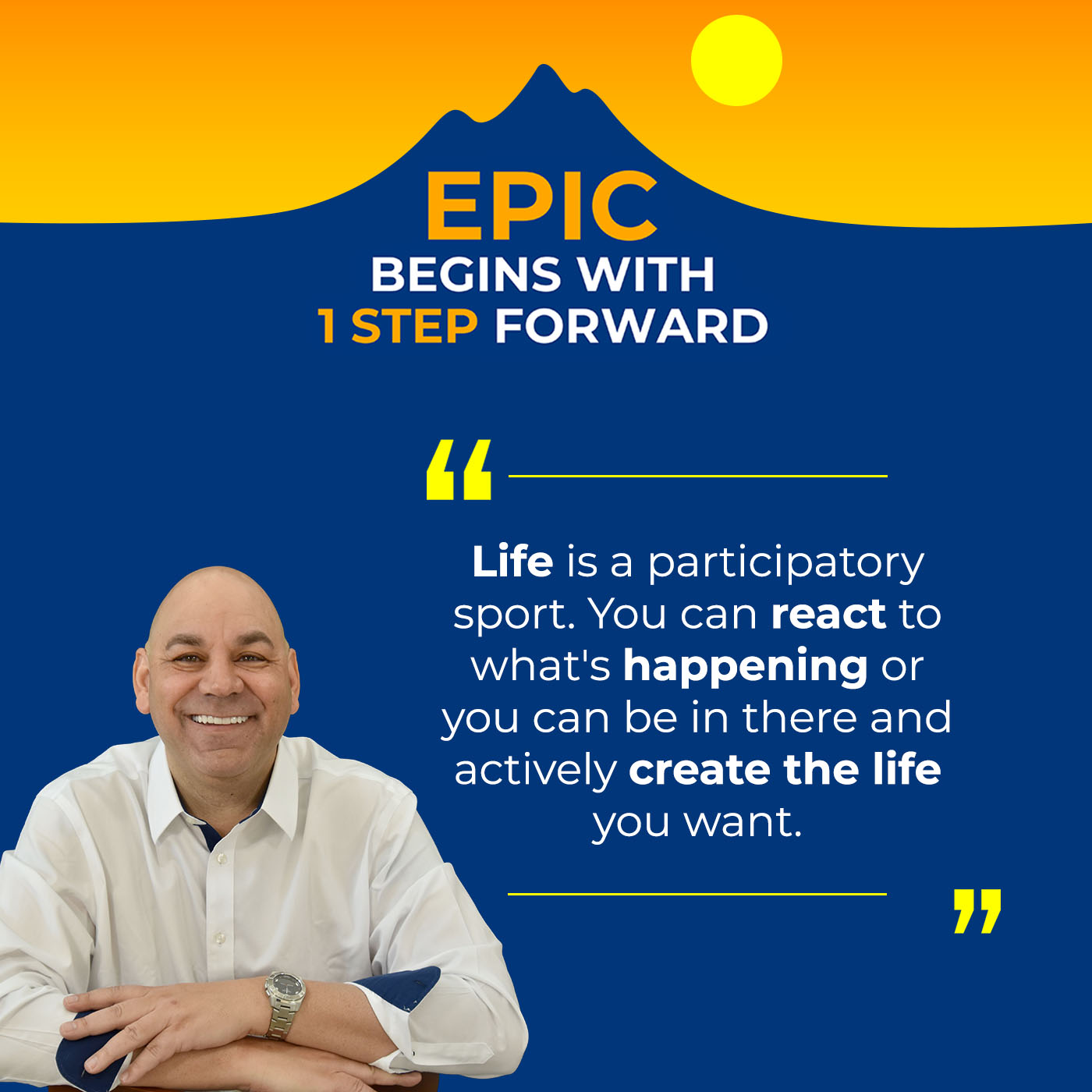
Yes, I would think so.
Yet, we were all getting excited because we found toilet paper. All of a sudden, there was a shortage of toilet paper, or you’re not going to be able to leave your house and do anything. What are you talking about? There’s going to be a pandemic. Those don’t happen here. Those happen over there. Yet, we had all these changes, and it has fundamentally changed all of us.
The whole world has become different after COVID.
Now you hear someone sneeze, and you get scared.
Some interesting things happened also. With all the focus on remote work, that has significantly changed. Remote work was not the thing back then. Now everything is remote. A lot of things changed as well as part of COVID, remote work, remote consultants, remote coaching, remote courses. The world has changed in the last three years. It was a combination of difficulties and opportunities.
There are all kinds of stuff, but there is some positive that has come out of all of that. You’re right, the remote work, that proof of concept that a company can still run, and everyone doesn’t have to be in the office.
That is a seismic shift in the industry.
I guess I’m happy I’m not in commercial real estate in the Bay Area right now because that’s a tough challenge.
It is, especially in these days.
There are good things. One of the benefits I can say is as a therapist, I’m now able to do telehealth. I can see my clients over a secured connection like Zoom. That is so much better for my clients and it’s so much better for me. I don’t have to deal with the overhead of having an office and all of that. My clients can meet with me when it’s convenient for them.
It has become time-efficient, for sure.
It has helped provide more access, not just for mental health but for healthcare in general. Maybe you need to talk to your doctor but you don’t need to be in person with them. Now your doctor can do a couple of video calls and video appointments, see more patients, and give you more access. If you have to go in, great.
It’s better for you as a patient because you didn’t drive to the doctor’s office to find out you’re okay, “Doc, what about this mole?” They can take a look at it and go, “Don’t worry about it. You’re fine. We’ll note it down, but you’re fine.” Versus you leaving work, going to the doctor’s office, and they take a look for five seconds, and you’re fine. Just an example. Our time is almost up. I wanted to give you an opportunity to share how people can get ahold of you. Any other things from your book or from your work that you’d like to share?
The Seven-Step Framework For Goal Achievement
I’ll first share a quick summary of the book’s framework so people understand. Any goal you want to achieve is a very simple seven-step process. I’ll go through it very quickly. 1) Begin with the end in mind. 2) Become accountable. 3) Define milestones. 4) Take one day at a time. 5) Bounce back after a setback. Inevitably get setbacks. You have to bounce back after a setback. 6) Quit strategically. There are some goals not worth chasing. You might always quit and say, “I will not pursue this goal.” It’s fine. As Zander mentions, 7) Enjoy the journey. If you’re not having fun, something is going wrong with your goals or the approach to achieving the goal.
Success comes from a simple 7-step process: Begin with the end in mind, be accountable, define milestones, take it day by day, bounce back from setbacks, know when to quit, and enjoy the journey!
Those are my quick tips in terms of goal setting. For people who want to know more about me and my work, go to my website, Changesmith.me, like blacksmith or goldsmith. It’s a single word. Everything you want to know about me is there. You can subscribe to my free newsletter. I send a piece of inspiring content every Saturday morning at 8:00 Pacific time. You can explore the book and my digital courses, my background, as well as my live courses. Changesmith.me is the place to go.
I want to thank you so much for joining me. This has been fascinating. I think your book is going to help a lot of people. I want to remind my audience that you can go to EpicBegins.com to find all the epic things that I have going on. If you go there today, you can get a free copy of Epic Begins with One Step Forward: How to Plan, Achieve, and Enjoy the Journey. As always, I want to remind people that epic choices lead to the epic life that you want.
Important Links
- www.Changesmith.me
- www.EpicBegins.com
- Epic Begins with One Step Forward: How to Plan, Achieve, and Enjoy the Journey
About Pramoda Vyasarao
 Pramoda Vyasarao, the founder of Changesmith Coaching LLC, has a rich background in computer science and boasts over two decades of experience with tech giants like Oracle and Meta. Beginning his career as an engineer and eventually transitioning into a management role, he recognized the importance of structured leadership development. This realization spurred his journey into leadership coaching.
Pramoda Vyasarao, the founder of Changesmith Coaching LLC, has a rich background in computer science and boasts over two decades of experience with tech giants like Oracle and Meta. Beginning his career as an engineer and eventually transitioning into a management role, he recognized the importance of structured leadership development. This realization spurred his journey into leadership coaching.
With 17 years of coaching experience, Pramoda has made a significant impact on thousands of individuals across 11 countries. He specializes in fostering personal growth for senior leaders through one-on-one coaching and cohort-based courses that focus on communication, leadership, and storytelling. Residing in California, he lives with his wife, Anusha, their son, Samyak, and their Sulcata tortoise, Taco.
